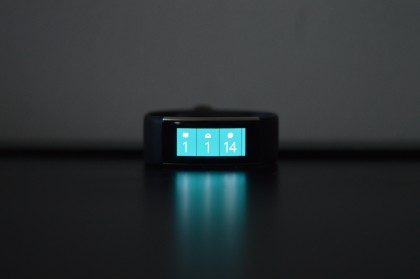Why you can trust TechRadar
The same 10 sensors are still jammed into the Microsoft Band 2: an optical heart rate sensor, 3-axis accelerometer, gyrometer, GPS, ambient light sensor, skin temperature sensor, UV sensor, capacitive sensor, microphone and a galvanic skin response sensor – with the addition of a barometer.
This means you'll get all the metrics from before, plus measurements of elevation gains from hiking or biking uphill, not to mention climbing steps.
The placement of the sensors are different this time around. You can see the mic and barometer on the sides of your Microsoft Band 2 and the heart rate monitor and galvanic skin response (GSR) contact points on the inside surface. The charging port and UV monitor are on the clasp. Other items, like the accelerometer and GPS, are sealed inside behind the display.

Like the first Band, the Band 2 isn't waterproof but remains dust and water resistant. With the IP67 rating, it can stand temporary immersion in water at a depth of 1 meter for 30 minutes, but it's not recommended and could ruin the tracker.
The lack of waterproofing is an unfortunate downside of the Bands, but I suppose sealing in the sensors would have hiked up the price a bit more. Still, it means I can't take this wearable swimming or kayaking to measure my metrics, which is disappointing.
Interface
The processing unit has remained the same as the first Band - 64MB internal storage and an ARM Cortex M4 MCU - though I've noticed a slight change to the speediness of the interface. The operating system still isn't Windows 10, but whatever changes were made show through, for the better.
The interface largely remains the same – tiles and apps laid out in a row. Again, same guts, but the performance has improved. There's less lag throughout when scrolling, and the Band 2 is much quicker to respond when pressing the home button.

Press the power button to see the Me Tile, which is the home screen on your Band. From the Me Tile, swipe left to see the rest of your tiles on the Start Strip.
From the Me Tile, you can tap to see the progress you've made toward your goals. Press the action button to cycle through the indicators for your heart rate, miles walked and ran, calories burned and floors climbed. Drag the tile to the right to see the status bar showing battery level, daily heart rate monitor status (if the heart monitor is turned on) and Bluetooth status (if Bluetooth is turned on).
Just like the first Band, head to the Microsoft Health app on your mobile device to load tiles and rearrange or delete them.

There are a few new colors and designs you can customize your Band 2 with. The watchface is also back with a twist called "Rotate on." The new watch mode will ask which wrist you wear your Microsoft Band 2 on and whether you wear it with the display facing outward or inward. Then, much like smartwatches out there, the clock will pop on when you turn your wrist.
Current page: Specs, performance, interface and apps
Prev Page Design and comfort Next Page Apps and fitnessCameron is a writer at The Verge, focused on reviews, deals coverage, and news. He wrote for magazines and websites such as The Verge, TechRadar, Practical Photoshop, Polygon, Eater and Al Bawaba.

